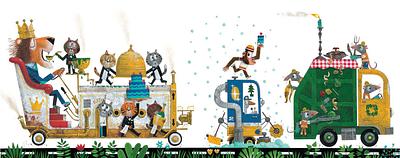Looking for all Articles by Early Years team?
Advice for sharing wordless picture books
Wordless picture books have a big role to play in helping children develop their language and literacy skills

A picture can be worth a thousand words, and in the case of a wordless picture book, maybe even more. Wordless picture books have a big role to play in helping children develop their language and literacy skills and sharing a wordless picture book is every bit as important as sharing stories with printed text. Learning to read the pictures and notice the fine details is a vital part of visual literacy – helping children make sense of what they see.
Researchers at the University of Waterloo(this link will open in a new window) have found that wordless picture books helped to extend toddlers' language. Although the study compared wordless picture books to vocabulary books where objects are named, the study found that the wordless picture books encouraged the mothers in the study to use more complex language with their toddlers. One reason for this might be that there is more scope to share a version of the story that relies on their own interpretation, rather than sticking to the printed text. Another advantage to this is that the reader can align the story to match the children's interest, and also alter the language to an appropriate level.
Wordless books can sometimes challenge the reader. Some readers will find it more difficult to share a book where they have to infer the meaning from the illustrations. Nonetheless, these book sharing experiences are all vital to children's language and literacy development– and most importantly, to helping them develop a love of books and reading.
Top tips for sharing wordless books
Describe what you see
Describing the pictures encourages us to use language that is different from how we normally speak. This will expose children to a rich variety of language. Look at the pictures and try to work out what is happening. Look for similarities and differences between the illustrations to help children make sense of the plot.
Point things out
Take your time and point things out in the pictures. Pointing and labelling helps children to learn the meaning of new words. This will also help draw their attention to details in the illustrations. Take the time to notice what the children are interested in and expand on those points.
Go beyond the pictures
Ask the children open ended questions about what might be happening and why. Be sure to give children plenty of time to think about their responses. When children reply, repeat what they say and add more information. For example, if a child points out a cat, describe the cat – "that’s right, there is a black cat".
Use story language
When you’re reading the story, try using simple words and phrases like ‘next' and 'then’. These linking words help children catch the idea of the flow of a story and how to tell a story in order.
Play with the story
You don’t always have to tell the story in the same way. If there is more than one character in the book, tell the story from different perspectives. You can make up a different story every time. That's one of the greatest things about a wordless book – you can change the story every time you read it!
Wordless picture books are a great way to engage young and reluctant readers. They’ll love the chance to be involved in the reading and telling of the story. A picture really is worth a thousand words! Find your next wordless picture book on our brand new Wordless Wonders (this link will open in a new window)book list.